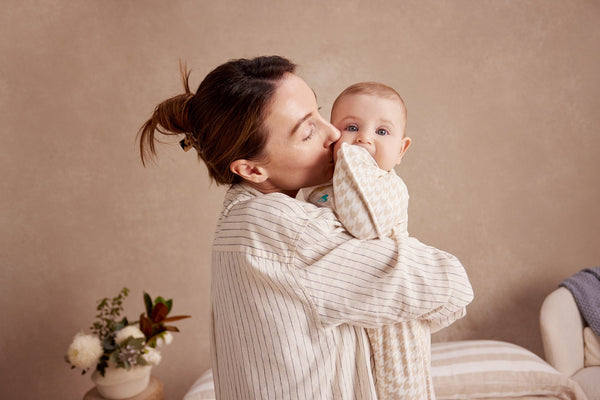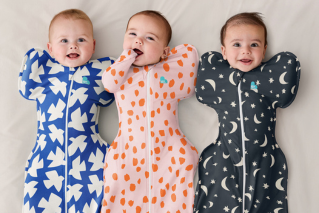What is the ideal room temperature for babies?
The ideal baby’s room temp is generally between 18-22 degrees Celsius.
Why is room temperature important for a baby?
It’s important that babies don’t overheat while they’re sleeping and that the room is properly ventilated. Overheating has been linked to an increased risk in SIDS (Sudden Infant Death Syndrome). Overheating can be caused by room heating, high body temperature, an excessive amount of clothing and/or bedding, or covering baby’s head. Babies regulate their temperature through their head and face, so it’s important that when your baby goes to nap or for their nighttime sleep they are not wearing any sort of head covering, hat or beanie.
How do you know if a baby is too hot or too cold?
Parents can spend a lot of time worrying about their baby’s room temperature and if their child is too hot or too cold during sleep. The best way to check your baby’s body temperature is to feel the back of their neck and chest, rather than their hands or feet.
Signs your baby is too hot
- Sweating
- Flushed cheeks
- Skin is clammy to touch
- Rapid breathing
Signs your baby is too cold
- Skin feels cool to the touch.
- Baby waking and unsettled mid-sleep, often in -line with a temperature drop.
How to check if your baby is too hot or too cold
Often the first port of call for parents when checking their baby’s temperature is to feel their hands and feet. However, due to a baby’s developing circulatory system, babies’ hands can feel cold when they are at a perfectly comfortable temperature. Here’s what to do to check your baby’s temperature while they’re sleeping:
Feel your baby’s chest or the back of their neck:
Rather than feeling your baby’s hands to test their comfort temperature, gently feel the back of their neck or chest to gauge how comfortable they are.
Listen to their breathing:
If your baby is overheating, their breathing can become more rapid. If you notice the speed of your baby’s breathing increase, it could be a sign that they are too hot and it’s time to remove some layers.
How to keep your baby a comfortable temperature during sleep
There are a few things you can do to ensure your baby remains at a comfortable temperature during the night:
Put your baby down to sleep on their back:
Putting your baby to sleep on their back allows them to regulate their own temperature more effectively.
Keep your baby’s crib free of blankets, loose sheets and pillows:
While it may seem like a nice idea, loose blankets, sheets and pillows in a baby’s cot are not recommended for safety reasons. You must ensure that your baby’s face cannot become covered through the night. Babies lack the strength to move themselves away from anything that may obstruct their breathing during sleep, so instead opt for a well-fitting swaddle or safe sleeping bag with safety features such as fitted necks and armholes (or sleeves).
Avoid over-dressing your baby at night:
Ensure your baby is dressed in lightweight, breathable clothing and they are not wearing a beanie, hat or head covering. Babies regulate their temperature through their head and face, therefore covering your child’s head overnight increases the risk of overheating.
Choose lightweight layers, rather than heavy sleepwear:
The advantage of dressing your baby in lightweight layers, such as bodysuits and rompers underneath a sleeping bag or swaddle, is that you can remove or add layers if the room temperature fluctuates during the night, or if you’ve noticed your baby is not at a comfortable temperature. Thick, heavy garments can lack breathability and may cause overheating. If you are unsure of a suitable layering combination for your baby’s current room temperature, our you can find dressing suggestions for different baby room temperatures on our TOG rating guide can help with a range of suggestions to suit different baby room temperature.
What can you do if your baby’s room is too warm?
If it’s likely that the temperature of the room will rise above 22°C, make sure your baby is dressed in lightweight, breathable clothing and a swaddle with a low TOG rating. In very high temperatures, you can use a fan in the room to circulate the air. Important: ensure the fan is a safe distance away from the cot/bassinet and not in direct line with your baby.
What can you do if your baby’s room is too cold?
On cooler evenings, dressing your baby in breathable layered clothing, with a temperature-appropriate swaddle or sleep bag could be all you need to ensure that baby is warm enough through the night. If you find your baby is not warm enough, you can add an extra layer underneath the sleep bag or swaddle.
While room thermometers can be a helpful aid in creating the ideal sleeping temperature for your baby, remember that dressing your baby appropriately and according to the climate is key. TOG (Thermal Overall Grade) ratings on clothing and sleep apparel are another helpful way of helping you choose the right sleepwear for the season and temperature.
Check in with your baby during the night if you know the temperature is due to fluctuate. For more helpful advice on dressing your child safely for sleep, visit our Blog.











